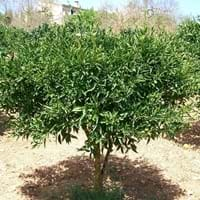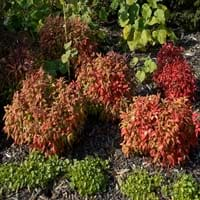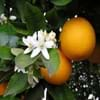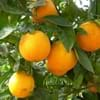Life Span
Perennial
Perennial
Type
Fruit
Broadleaf Evergreen
Origin
Southern Asia, India, Melanesia, Australia
China, Japan
Types
etrog
Heavenly Bamboo, Nandina 'Colerno'
Dwarf Nandina 'Compacta'
Dwarf Nandina 'Filamentosa'
Heavenly Bamboo, Nandina 'Harbor Belle'
Heavenly Bamboo, Nandina 'Moon Bay'
Number of Varieties
Not Available
Habitat
Mediterranean region, Subtropical climates, Tropical regions
low mountains, Mountain tops, Mountains, Valley
USDA Hardiness Zone
9-11
6-11
AHS Heat Zone
12-9
Not Available
Sunset Zone
H1, H2, 8, 9, 12, 13, 14, 15, 16, 17, 18, 19, 20, 21, 22, 23, 24
21,22
Habit
Oval or Rounded
Clump-Forming
Flower Color
White, Purple
Not Available
Flower Color Modifier
Bicolor
Bicolor
Fruit Color
Yellow
Not Available
Leaf Color in Spring
Green, Dark Green
Green, Purple, Copper
Leaf Color in Summer
Green, Dark Green
Green, Purple
Leaf Color in Fall
Green, Dark Green
Green, Purple
Leaf Color in Winter
Light Green
Red, Green, Purple
Leaf Shape
Ovate elongated
Acuminate
Plant Season
Spring, Summer, Fall, Winter
Spring, Summer, Fall, Winter
Sunlight
Full Sun, Partial Sun
Full Sun, Partial Sun, Partial shade, Full Shade
Growth Rate
Medium
Medium
Type of Soil
Clay, Loam, Sand
Loam, Sand
The pH of Soil
Acidic, Neutral
Acidic, Neutral, Alkaline
Soil Drainage
Well drained
Well drained
Bloom Time
Early Spring, Spring, Winter, Late Winter, Indeterminate
Not Available
Tolerances
Drought
Drought
Where to Plant?
Ground
Ground
How to Plant?
Seedlings, Transplanting
Seedlings
Plant Maintenance
Medium
Medium
Watering Requirements
Needs less watering
Do not water frequently, Needs less watering
In Summer
Lots of watering
Lots of watering
In Spring
Moderate
Moderate
In Winter
Average Water
Average Water
Soil pH
Acidic, Neutral
Acidic, Neutral, Alkaline
Soil Type
Clay, Loam, Sand
Loam, Sand
Soil Drainage Capacity
Well drained
Well drained
Sun Exposure
Full Sun, Partial Sun
Full Sun, Partial Sun, Partial shade, Full Shade
Pruning
Remove damaged leaves, Remove dead branches, Remove dead leaves
Remove damaged leaves, Remove dead branches, Remove dead leaves
Fertilizers
All-Purpose Liquid Fertilizer
All-Purpose Liquid Fertilizer
Pests and Diseases
Aphids, Citrus foot rot, Leafminers, Red blotch
Red blotch
Plant Tolerance
Drought
Drought
Flowers
Showy
Not Available
Flower Petal Number
Single
Not Available
Fragrant Bark/Stem
Yes
No
Foliage Texture
Medium
Fine
Foliage Sheen
Glossy
Glossy
Attracts
Birds, Butterflies
Mealybugs, Whiteflies
Allergy
Mild Allergen
Not Available
Aesthetic Uses
Showy Purposes
Bonsai, Borders
Beauty Benefits
Brightens the skin complexion, Good for skin and hair
Not Available
Environmental Uses
Air purification
Air purification
Medicinal Uses
Antibiotic, Antidote, Pulmonary afflictions, Recovering internal injuries
Antirheumatic, Antitussive, Astringent
Part of Plant Used
Fruits, Leaves
Fruits, Leaves
Other Uses
Used as a nutritious food item, Used As Food, Used for its medicinal properties
Used for making informal hedge
Used As Indoor Plant
No
No
Used As Outdoor Plant
Yes
Yes
Garden Design
Container, Edible, Feature Plant, Fruit / Fruit Tree, Hedges, Houseplant, Shade Trees, Topiary / Bonsai / Espalier, Tropical
Container, Edging, Foundation, Groundcover, Hedges, Mixed Border, Topiary, Bonsai, Espalier
Botanical Name
CITRUS medica
NANDINA domestica 'Nana Purpurea'
Common Name
Citron
heavenly bamboo
sacred bamboo
nandina
In Hindi
नीबू
Dwarf Nandina
In German
Zitrone
Dwarf Nandina
In French
Citron
Nandina Dwarf
In Spanish
Cidra
Nandina enana
In Greek
Κίτρο
Dwarf Nandina
In Portuguese
cidra
Nandina do anão
In Polish
Cytryna
Dwarf Nandina
In Latin
Chron
Dwarf Nandina
Phylum
Magnoliophyta
Tracheophyta
Class
Magnoliopsida
Magnoliopsida
Order
Sapindales
Ranunculales
Family
Rutaceae
Berberidaceae
Clade
Angiosperms, Eudicots, Rosids
Angiosperms, Eudicots
Tribe
Citreae
Not Available
Subfamily
Aurantioideae
Not Available
Number of Species
Not Available
Not Available
Importance of Citron and Dwarf Nandina
Want to have the most appropriate plant for your garden? You might want to know the importance of Citron and Dwarf Nandina. Basically, these two plants vary in many aspects. Compare Citron and Dwarf Nandina as they differ in many characteristics such as their life, care, benefits, facts, etc. Every gardener must at least have the slightest clue about the plants he wants to plant in his garden. Compare their benefits, which differ in many ways like facts and uses. The medicinal use of Citron is Antibiotic, Antidote, Pulmonary afflictions and Recovering internal injuries whereas of Dwarf Nandina is Antirheumatic, Antitussive and Astringent. Citron has beauty benefits as follows: Brightens the skin complexion and Good for skin and hair while Dwarf Nandina has beauty benefits as follows: Brightens the skin complexion and Good for skin and hair.
Compare Facts of Citron vs Dwarf Nandina
How to choose the best garden plant for your garden depending upon its facts? Here garden plant comparison will help you to solve this query. Compare the facts of Citron vs Dwarf Nandina and know which one to choose. As garden plants have benefits and other uses, allergy is also a major drawback of plants for some people. Allergic reactions of Citron are Mild Allergen whereas of Dwarf Nandina have Not Available respectively. Having a fruit bearing plant in your garden can be a plus point of your garden. Citron has showy fruits and Dwarf Nandina has no showy fruits. Also Citron is not flowering and Dwarf Nandina is not flowering . You can compare Citron and Dwarf Nandina facts and facts of other plants too.





